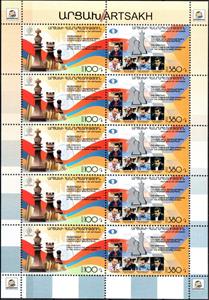Full Pane: Armenia, Silver Medalists at World Chess Olympiad (Artsakh (Nagorno-Karabakh) 2022)
Armenia, Silver Medalists at World Chess Olympiad (Artsakh (Nagorno-Karabakh) 2022)
30 September (Artsakh (Nagorno-Karabakh) ) within release Armenia, Silver Medalists at World Chess Olympiad (2022) goes into circulation Full Pane Armenia, Silver Medalists at World Chess Olympiad face value 2,400 Armenian dram
| Full Pane Armenia, Silver Medalists at World Chess Olympiad in catalogues | |
|---|---|
| Colnect codes: | Col: AZ-NK 2022.09.30-03a |
Full Pane is square format.
Also in the issue Armenia, Silver Medalists at World Chess Olympiad (2022):
- Stamp - Armenia, Silver Medalists at World Chess Olympiad face value 100;
- Full Pane - Armenia, Silver Medalists at World Chess Olympiad face value 10*100;
- Stamp - Armenia, Silver Medalists at World Chess Olympiad face value 380;
- Full Pane - Armenia, Silver Medalists at World Chess Olympiad face value 10*380;
- Se-tenant - Armenia, Silver Medalists at World Chess Olympiad face value 480;
- Full Pane - Armenia, Silver Medalists at World Chess Olympiad face value 2,400;
Full Pane Armenia, Silver Medalists at World Chess Olympiad it reflects the thematic directions:
Chess is usually played by two players (called chess players) against each other. It is also possible for one group of chess players to play against another or against one player; such games are often called consultation games. In addition, there is the practice of simultaneous play sessions, when several opponents play against one strong player, each on a separate board.
The rules of the game were basically developed by the 15th century; In modern official tournaments, the rules of the International Chess Federation[6] are applied, which regulate not only the movement of pieces, but also the rights of the judge, the rules of behavior of players and time control. A game played remotely - for example, by correspondence, by telephone or via the Internet - has special rules. There are many variants of chess that differ from classical ones: with non-standard rules, pieces, board sizes, etc. The corresponding section of chess composition is fairy chess. Some aspects of the game of chess are studied in mathematics (for example, the classic “Knight's Move Problem” and “Eight Queens Problem”), including through computer simulation. Chess is usually played by two players (called chess players) against each other. It is also possible for one group of chess players to play against another or against one player; such games are often called consultation games. In addition, there is the practice of simultaneous play sessions, when several opponents play against one strong player, each on a separate board.
The rules of the game were basically developed by the 15th century; In modern official tournaments, the rules of the International Chess Federation[6] are applied, which regulate not only the movement of pieces, but also the rights of the judge, the rules of behavior of players and time control. A game played remotely - for example, by correspondence, by telephone or via the Internet - has special rules. There are many variants of chess that differ from classical ones: with non-standard rules, pieces, board sizes, etc. The corresponding section of chess composition is fairy chess. Some aspects of the game of chess are studied in mathematics (for example, the classic “Knight's Move Problem” and “Eight Queens Problem”), including through computer simulation.
A flag is a piece of fabric (most often rectangular or quadrilateral) with a distinctive design that is used as a symbol, as a signaling device, or as decoration. The term flag is also used to refer to the graphic design employed, and flags have since evolved into a general tool for rudimentary signalling and identification, especially in environments where communication is similarly challenging (such as the maritime environment where semaphore is used). National flags are patriotic symbols with varied wide-ranging interpretations, often including strong military associations due to their original and ongoing military uses. Flags are also used in messaging, advertising, or for other decorative purposes. The study of flags is known as vexillology, from the Latin word vexillum, meaning flag or banner.


